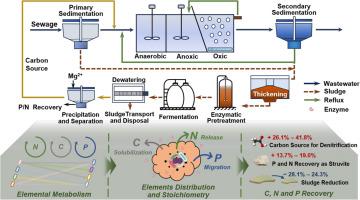Recovery of C, N, and P from waste activated sludge by enzymatic anaerobic fermentation: Stoichiometry and metatranscriptomics analysis
IF 10.9
1区 环境科学与生态学
Q1 ENGINEERING, ENVIRONMENTAL
引用次数: 0
Abstract
The recovery of C, N, and P elements by sludge biorefinery potentially reduces operation costs and increases the extra benefits. Herein, we analyzed the elemental stoichiometry of C, N, and P and functional microbiome involved in enzymatic anaerobic fermentation. Enzymatic hydrolysis was observed to increase the release of C, N, and P into the sludge supernatants by 21.8 %–26.3 %. Metatranscriptome analysis indicated that enzymatic pretreatment enhanced the metabolism of the organic carbon degradation, ammonium conversion, and P solubilization in subsequent fermentation. Specifically, enzymatic pretreatment enhanced endogenous carbon hydrolase activity by 48.4 %–72.7 % and upregulated intra-C metabolic pathways, such as glycolysis and pyruvate metabolism. Ammonium transport and conversion were significantly increased by 4–6 fold, stimulating the synthesis of glutamine and endogenous amino acids. Additionally, enzymatic hydrolysis promoted phosphatase secretion and enhanced bacterial P uptake. These effects improved the recovery of C, N, and P as dentification carbon source and struvite by 13.7 %–41.8 % and the dry sludge production was reduced by 24.3 %–28.1 %. Life cycle assessment (LCA) indicated the shift of CO2 emissions from net positive to net negative levels as compared to the conventional A2/O process. This study offers valuable insights into the redistribution and metabolism of various elements involved in the enzymatic anaerobic fermentation, and proposes the potential strategy to recovery C, N, and P from sewage via sludge biorefinery.

利用酶促厌氧发酵从废活性污泥中回收碳、氮和磷:化学计量学和超转录组学分析
通过污泥生物精馏回收碳、氮和磷元素有可能降低运营成本并增加额外效益。在此,我们分析了C、N和P的元素化学计量学和参与酶促厌氧发酵的功能微生物群。酶解可使污泥上清液中碳、氮和磷的释放量增加21.8% - 26.3%。超转录组分析表明,酶处理促进了有机碳降解、铵转化和磷在后续发酵中的溶解代谢。具体来说,酶预处理使内源性碳水解酶活性提高了48.4% - 72.7%,并上调了c内代谢途径,如糖酵解和丙酮酸代谢。铵的转运和转化显著增加了4-6倍,刺激了谷氨酰胺和内源氨基酸的合成。此外,酶解促进了磷酸酶的分泌,增强了细菌对磷的吸收。这些效果提高了作为识别碳源的C、N、P和鸟粪石的回收率13.7% ~ 41.8%,干污泥产量减少24.3% ~ 28.1%。生命周期评估(LCA)表明,与传统的A2/O过程相比,CO2排放量从净正水平转变为净负水平。本研究对酶促厌氧发酵中各种元素的再分配和代谢提供了有价值的见解,并提出了通过污泥生物精馏从污水中回收C、N和P的潜在策略。
本文章由计算机程序翻译,如有差异,请以英文原文为准。
求助全文
约1分钟内获得全文
求助全文
来源期刊

Resources Conservation and Recycling
环境科学-工程:环境
CiteScore
22.90
自引率
6.10%
发文量
625
审稿时长
23 days
期刊介绍:
The journal Resources, Conservation & Recycling welcomes contributions from research, which consider sustainable management and conservation of resources. The journal prioritizes understanding the transformation processes crucial for transitioning toward more sustainable production and consumption systems. It highlights technological, economic, institutional, and policy aspects related to specific resource management practices such as conservation, recycling, and resource substitution, as well as broader strategies like improving resource productivity and restructuring production and consumption patterns.
Contributions may address regional, national, or international scales and can range from individual resources or technologies to entire sectors or systems. Authors are encouraged to explore scientific and methodological issues alongside practical, environmental, and economic implications. However, manuscripts focusing solely on laboratory experiments without discussing their broader implications will not be considered for publication in the journal.
 求助内容:
求助内容: 应助结果提醒方式:
应助结果提醒方式:


